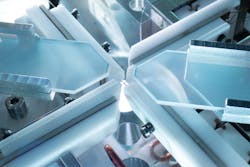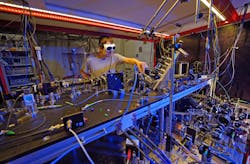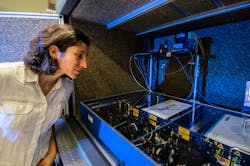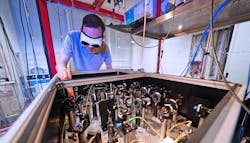How can information encoded in atoms or molecules be exchanged with single photons without corruption or loss? That is the key problem with which laser physicist Professor Gerhard Rempe, a director of the Max Planck Institute for Quantum Optics (MPQ; Garching, Germany), and his research group are concerned. In their efforts to solve it, they have designed optical resonators made up of pairs of mirrors placed in diametrically opposite positions in an ultrahigh-vacuum chamber (see Fig. 1). The volume enclosed by such an optical cavity is much less than a cubic millimeter, but the reflectivity of the mirrors is extremely high. Once inside a resonator, a photon will be reflected on the order of 100,000X before it is transmitted through one of the mirrors.
In their experiments, the researchers prepared a single atom, which has been cooled to a temperature of much less than 1 mK and place it in a resonator or at the center of two crossed resonators positioned orthogonally to each other (see Fig. 2). If a photon were to interact with the atom only once, the interaction would be very weak. However, because each photon makes the round trip between the cavity’s mirrors many times, the interaction is correspondingly amplified.Rempe and his team have used this configuration as the basis for the construction of novel light sources that generate a stream of single-photon bits, and even quantum mechanically entangled photons, on demand.1 In addition, the setup can be used to transfer quantum information encoded in a single photon to the atom in a controlled manner.2 Furthermore, the group has shown that the presence or absence of a single photon can be nondestructively measured without altering the information encoded in the particle. That’s roughly analogous to checking whether there is a letter in the post office box without reading the content of that letter. However, it’s much more difficult to verify the arrival of a quantum letter without reading the quantum content.3 Experiments such as these are being performed in several of the group’s laboratories.
Rempe is one of the initiators in the field of cavity quantum electrodynamics. In 1987, he was the first person to demonstrate the repeated absorption and re-emission of a single microwave photon by a single atom. He went on to study how optical photons behaved when introduced into cavities formed by highly reflective mirrors. With this work, he became one of the pioneers of cavity quantum electrodynamics in the optical frequency range.
Controlling parameters
All such experiments demand a very high degree of control over many parameters. For instance, they very often involve several laser systems tuned to different frequencies, all of which must be stabilized with high precision—until about 15 years ago, herculean efforts were required to achieve this. The problems relate primarily to the effects of thermal expansion, acoustic vibrations, and noise introduced by the electronics. Every change in any one of these parameters can alter the frequencies emitted by the lasers in the setup.
The remedy was provided by one of Rempe’s colleagues at MPQ, Professor Theodor Hänsch. Around the turn of the millennium, together with Professor John Hall, Hänsch developed the concept for an extremely stable frequency standard. In 2005, Hänsch and Hall received the Nobel Prize in Physics for the development of an extremely stable frequency comb. This is essentially a laser that emits a train of ultrashort light pulses. Measurement of the output reveals that the emission is made up of many frequencies, which are distributed in a fashion that is reminiscent of the teeth of a comb. Those teeth are equally spaced in the frequency domain; the position of each tooth is highly stable, and its frequency can be very accurately determined. The teeth can therefore be thought of in the same way as the divisions on a ruler and can be used to measure frequencies instead of spatial distance. To stabilize the frequency of another laser, its emission is superimposed on the output of the comb. The resulting distribution of light intensity is found to include a beat note at a frequency that is identical to the offset between the frequency of the laser and that of the closest tooth of the frequency comb. Armed with this information, one can readily stabilize the frequency of the laser to any desired value.
With the aim of making the frequency comb technology commercially available to a wide range of users, Hänsch—in collaboration with Michael Mei and Ronald Holzwarth—founded Menlo Systems (Martinsried, Germany).
“Prior to the advent of the frequency comb, we had stabilized all of our lasers with the aid of optical resonators referenced to spectroscopic signals,” says Rempe. “But it was a laborious procedure, and the results were less precise and more sensitive to environmental fluctuations.” Then, the frequency comb came along. “In those days,” he adds, “the system had not yet been commercialized, and it wasn’t clear how it would behave under continuous operation. In this respect, we were the guinea pigs. The most important question was how stable the early frequency combs would turn out to be over the very brief periods that were of greatest interest to us.”Ongoing experiments
With the aid of frequency comb technology, Rempe can now extend his group’s experiments in quantum electrodynamics from the level of single atoms to single molecules.
“Molecules are far more difficult to handle than atoms, simply because they are made up of more particle species,” says Dr. Stephan Dürr, a member of Rempe’s research team.
In 2000, groups began to develop methods that made it possible to slow down the motions of many different molecular species in the gas phase, and then to store them.4 Rempe’s team has also made pivotal contributions to basic research in this area. Thanks to the development of a highly ingenious cooling procedure, it is now possible to cool very large numbers of molecules to extremely low temperatures (see Fig. 5).5 At present, the group is considering probing the interaction of these molecules with photons in essentially the same way as they have explored the effects of photons on individual atoms.“We are now refining our setup with a view to increasing the size of these quantum systems by systematically increasing the numbers of atoms or photons and perhaps even molecules they contain,” Dürr says.
According to Rempe, the team’s goal is “to ascertain whether it is possible to construct local quantum networks—or an extended quantum internet consisting of distributed quantum computers—in which information exchange between nodes is mediated by single photons.”
REFERENCES
1. T. Wilk et al., Science, 317, 488–490 (2007); doi:10.1126/science.1143835.
2. M. Brekenfeld et al., Nat. Phys., 16, 647–651 (2020); doi:10.1038/s41567-020-0855-3.
3. D. Niemietz et al., Nature, 591, 570–574 (2021); doi:10.1038/s41586-021-03290-z.
4. H. L. Bethlem et al., Nature, 406, 491–494 (2000); doi:10.1038/35020030.
5. M. Zeppenfeld et al., Nature, 491, 570–573 (2012); doi:10.1038/nature11595.
About the Author
Thorsten Naeser
Public Relations, Max Planck Institute of Quantum Optics
Thorsten Naeser is in public relations at the Max Planck Institute of Quantum Optics (Garching, Germany).




